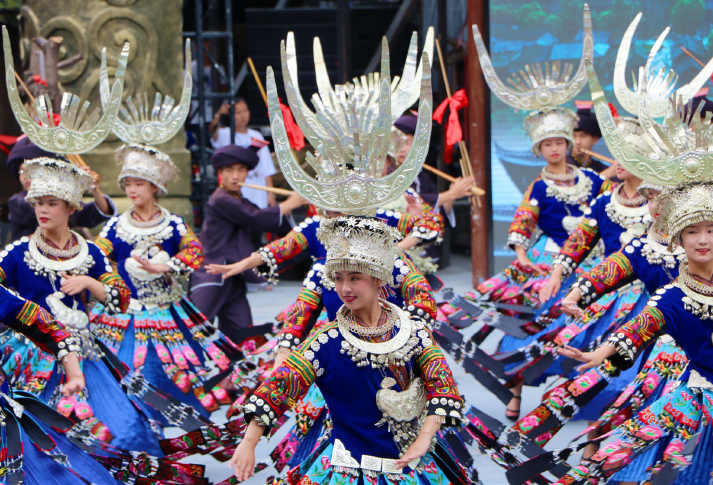|
||||||||||
| Home Nation World Business Opinion Lifestyle ChinAfrica Multimedia Columnists Documents Special Reports |
|
||||||||||
| Home Nation World Business Opinion Lifestyle ChinAfrica Multimedia Columnists Documents Special Reports |
| ChinAfrica |
| Tourism development helps people in remote ethnic areas shake off poverty |
| After more than 10 years of development, Xijiang has become a famous cultural tourism destination, and the poverty alleviation model by developing tourism has become a new approach for targeted poverty alleviation in China |
| By Li Kaizhi VOL.12 August ·2020-08-11 |

Numerous ancient villages and towns with distinctive ethnic characteristics are scattered across China. Xijiang Qianhu Miao Village is one of them.
Located in Leishan County, Guizhou Province in southwest China, the village, with more than 1,400 households and more than 6,000 people, is the world's largest village inhabited by people of the Miao ethnic group. Wang Jiawen is a native Miao woman of the village and works as a tour guide in the Xijiang scenic area.
Tourists are attracted to the village not only by the beautiful natural scenery, but also the culture of the Miao ethnic group. That keeps Wang busy. "Sometimes I get four batches of guests a day. Although I'm a little bit tired, it's all worth it," Wang said with a smile.
It's hard to imagine that the village was still dominated by traditional agriculture until 2008, and migrant work was the main source of household income of local villagers. Due to various factors like backward farming techniques and inconvenient transportation, the per-capita annual income of the villagers was as low as 1,700 yuan ($243) before developing tourism. But in 2019, their per-capita annual income reached 23,600 yuan ($3,372).
After more than 10 years of development, Xijiang has become a famous cultural tourism destination, and the poverty alleviation model by developing tourism has become a new approach for targeted poverty alleviation in China.

Scenic area development
Relying on rich natural and cultural resources with Miao characteristics, Xijiang has vigorously developed the tertiary industry focusing on sightseeing since 2008. "With more and more people visiting our village, we locals have more opportunities to contact with the outside world, which helps us shake off poverty," Wang told ChinAfrica.
"Tourism is a highly market-oriented industry. A long process of training is required to help people in ethnic areas enter the market," said Li Tianyi, a professor at Guizhou Minzu University. He holds that it is important to let local residents benefit from the process of tourism development.
"We have helped the poor in various ways including ticket-revenue sharing, employment in the scenic spots and promoting local products through e-commerce," said Shen Chengli, President of Xijiang Qianhu Miao Village Cultural Tourism Development Co. Ltd.
In 2010, the village established a benefit-sharing mechanism for the protection and development of ethnic culture, under which 18 percent of the total ticket revenue is distributed among the households in the community in the form of ethnic cultural protection award. From 2009 to 2017, the cumulative amount of the award was more than 100 million yuan ($14.3 million), and the amount of award per household exceeded 70,000 yuan ($9,996).
The village has also invited locals who are familiar with Miao singing and dancing and traditional Miao musical instruments to participate in performances for visitors.
"Participation in activities such as singing folk songs, welcome performances and folk custom shows not only brings employment opportunities to people like me, but also enables our Miao culture to be known by more people, which raises people's awareness about the inheritance and protection of our culture," Wang added.
In addition, the village has improved the rating and rewarding mechanisms for ethnic culture protection. Villagers who abide by the regulations on the protection of ethnic culture will be rewarded with benefits, and those who do not conform to management regulations and use or occupy the land in a disorderly manner shall be disqualified for rating and rewards.
In 2008, the total tourism revenue of Leishan was 285 million yuan ($40.7 million), in which the Xijiang scenic area accounted for 35 percent. In 2019, the county's total tourism revenue reached 11.897 billion yuan ($1.7 billion), with the Xijiang scenic area accounting for 63 percent. Meanwhile, the Xijiang scenic area has vigorously developed local tourism products aimed at poverty alleviation, driving the development of industries such as tea planting, silverware processing and embroidery in the county.
Family inns assistance
Daling Village in Liuxiang Township under Jinxiu Yao Autonomous County, Guangxi Zhuang Autonomous Region in south China, received more than 20,000 tourists in just four days during the May Day holiday this year. All the rooms of family inns in the village were booked. The old dwellings of the Yao ethnic group people who have lived for generations have turned into "money-spinners."
"Every year from April to October, many tourists stay at the family inns for one night to experience the unique Yao home environment. This is the biggest change for the village in recent years," said Mo Qiuming, Secretary of the branch of the Communist Party of China in the village.
In the past, despite the beautiful scenery, the village was isolated from the outside world. Also, only three houses in the village were tiled before 2015. To alter this situation, Mo and other village heads decided to develop family inns. They introduced Guangxi Shangbin Tourism and Culture Co. Ltd. and its ecological family inn project to the village.
The company purchased local timber and agricultural products worth 600,000 yuan ($85,740) and paid the involved villagers house rent of 150,000 yuan ($21,435) in the beginning. After seeing the boom in the business of the family inns, other villagers also got interested.
After the May Day holiday, Feng Wensheng, a villager, raised another 100,000 yuan ($14,290) to build new rooms in his existing two-story house. "In the past, all of our income came from growing star anise, but now we have diverse sources of income including those from the family inn business and local agricultural products. Our income has more than doubled compared with before," Feng said.
By running the family inn, Feng's family shook off poverty several years ago. "My family inn alone generates more than 30,000 yuan ($4,278) a year," he noted. In addition, he and his wife also sell local specialties online.
Today, Daling has eight family inns and two farmhouse resorts, with seven family inns under construction. From 2016 to 2019, the village received more than 386,000 tourists, realizing tourism income of more than 5 million yuan ($700,000). It directly lifted 215 people from 66 poor households out of poverty, creating a mode of tourism-driven poverty alleviation.
(Print Edition Title: Folklore Fascination)
Comments to likzh@chinafrica.cn
| About Us | Contact Us | Advertise with Us | Subscribe |
| Copyright Beijing Review All rights reserved 京ICP备08005356号-5 京公网安备110102005860号 |